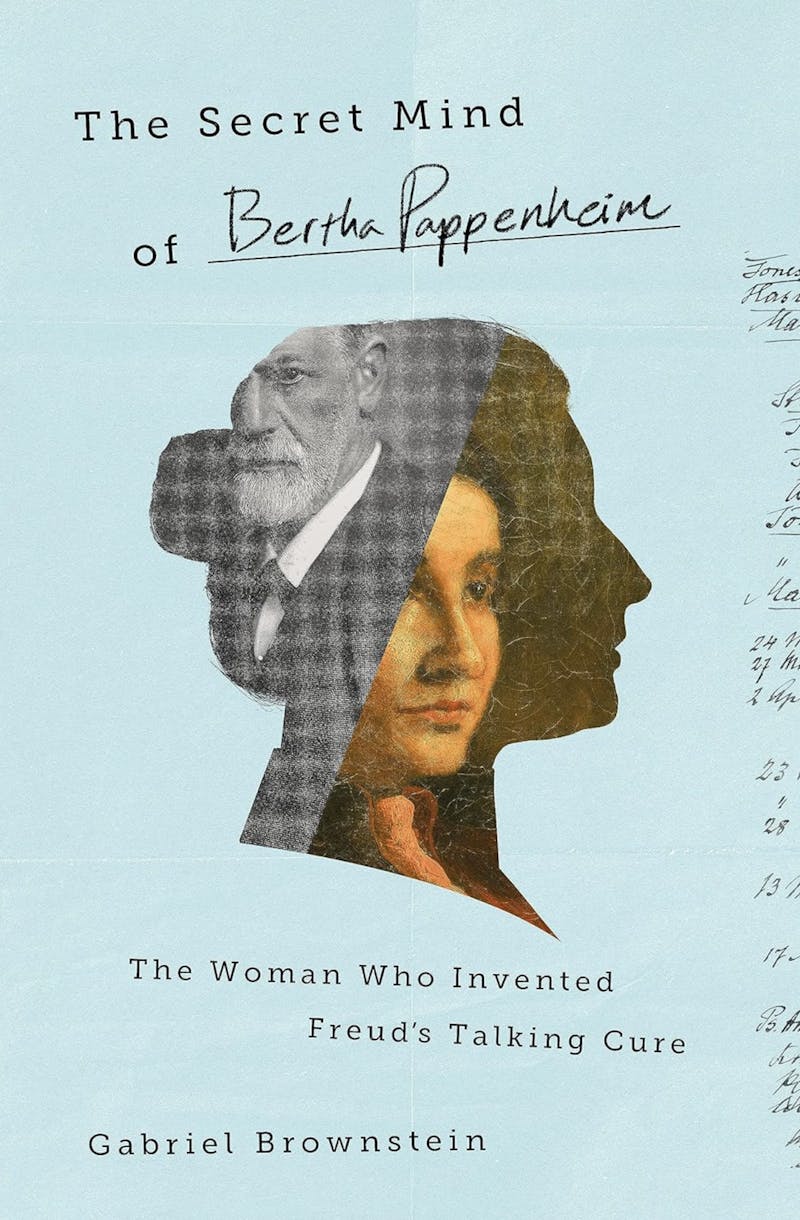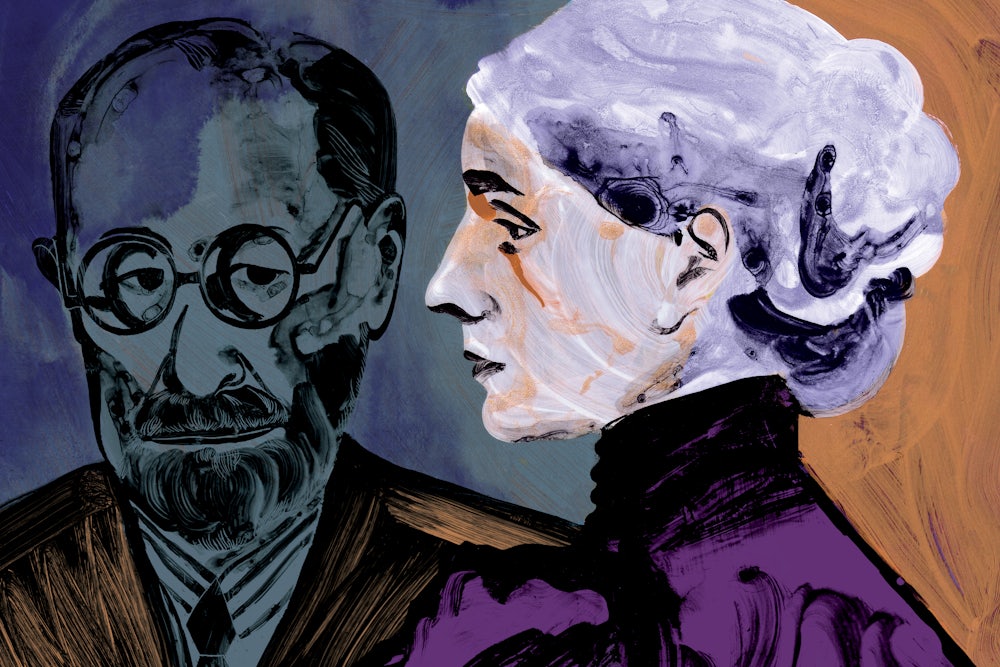There is perhaps no one more devoted to the cause than a convert, and there is no one more violent toward it than a person who has lost their faith. The faithful turned faithless take up the act of crusade, but in reverse: new atheists confronting the world with secular eyes, children who learn that their parents aren’t omnipotent. They have suffered the loss of an organizing principle, the very thing they built their life around. Now, they may seek revenge on the object that caused an earlier delusion. The commitment doesn’t end—it just takes on new guises.
Beyond the reactions of former lovers and former zealots, we see this in the history of psychoanalysis, perhaps because the practice attracts and demands those same qualities of immersion and devotion. Many have justly loved psychoanalysis, and many have justly despaired of it. This includes the very founders of rational emotive behavioral therapy and cognitive behavioral therapy, who brought about a sea change in mental health care, and the critics Frederick Crews, Jeffrey Masson, and Philip Rieff, who turned against Freud even after he had been unthroned as king of the twentieth century. This hatred can feel quasi-personal, aimed at the originator, their father figure, Sigmund Freud.

This loss of faith looms over Gabriel Brownstein’s book, The Secret Mind of Bertha Pappenheim: The Woman Who Invented Freud’s Talking Cure. On its face, the book is a study of the first analytic patient (although she didn’t exactly receive psychoanalytic treatment), Bertha Pappenheim. Pappenheim, who was treated by Freud’s mentor Josef Breuer in Vienna, was the subject of one of Breuer’s case studies and was much discussed by Freud throughout his own career. The book’s stated aim is to offer a full portrait of someone flattened and circulated as a specimen. For Pappenheim is best known by another name—Anna O.—and is best known not as her full person, who left a legacy of feminist and activist patronage, but as the world’s most famous hysteric.
But quietly, this is also a book about the birth and death of psychoanalysis—which is to say that the narrative of Freud’s ascendance and betrayal is the engine that drives the book. Brownstein argues, sometimes contradictorily, that Freud’s brilliance and his drive to make his way as a medical doctor propelled him to tamper with Bertha’s story.
Given that Pappenheim’s stunning cure is the origin story of psychoanalysis, Brownstein seeks to denigrate the whole endeavor on these grounds. If the Anna O. case was a fraud, so, too, would the cure be that she discovered.
Hysteria, much like psychoanalysis, has a storied past, one with a powerful crescendo followed by a caesura. Though the term “hysteric” is now assumed in common speech to be either a pejorative epithet, synonymous with performative hyper-emotionality (he was hysterical), or a historical diagnosis made up by misogynistic doctors (like, some argue, Breuer and Freud), the condition was once quite common. For the uninitiated, hysteria is an illness where the body speaks, where neurotic symptoms appear in and on it. It was treated by an array of cures, from gynecological massage (prescribed orgasm), hypnotism, rest, and drugging, to change of scenery, and, yes, for a very few patients, starting in the late nineteenth century, Breuer and Freud’s cathartic method. This eventually became psychoanalysis. This was, it must be said, a treatment that seems preferable to the other options.
Bertha Pappenheim was in many ways a typical hysterical patient, and an extraordinary woman. When she went to see Breuer in 1880, she presented with the typical hysterical complaints: partial paralysis, disturbances of appetite and language, pain. She couldn’t recall her native German and only spoke in English. She wouldn’t drink water. She had fallen ill while nursing her father, and her condition deteriorated upon his death. She was treated both in her home and in an asylum, often with high doses of drugs. What marks her case as special is that Pappenheim was the first person on Earth to be treated by the cathartic method, in large part because she invented it. Anytime you hear someone say “talking cure,” they’re using the very term Pappenheim ascribed to the yearslong experiment she undertook, morning and night, with her doctor. As she chattered on, as she engaged in the “chimney sweeping” of her mind—so the story goes—she felt better.
Freud and Breuer went on to co-write the groundbreaking Studies on Hysteria, published in 1895. The two doctors, one senior and one junior, open the book with a co-written introduction and end it with a pair of stand-alone essays (Freud’s undermining Breuer’s) in which the nascent theories of repression, defense, catharsis, and abreaction first appear. Each supplied case material of hysteric women treated by this nascent cathartic method. Freud wrote up four cases, and Breuer only contributed the case of Pappenheim, now disguised and named “Anna O.” The two detailed the symptoms of their patients and how each was aided, if not outright cured, by this new talking protocol.
In Breuer’s write-up of Anna O., which only runs about 25 pages, he elaborates on the case study, telling his readers how ill Anna was, when, and why. He then goes on to describe his therapeutic practice of sitting with her at night, and how, while Anna O. was under hypnosis, the two came to “develop a therapeutic technique” of linking each of her symptoms to the moment it appeared. The water she will not drink, for instance, is linked to a moment she saw her English ladies’ companion let a little dog drink from her glass. After the connection is revealed under hypnosis, Breuer tells us, Anna O. drinks water once more. The process repeated until there were no symptoms left, and Anna O.’s mental state presumably returned to normal.
The problem is—and basically all historians of psychoanalysis agree on this point—that even though Breuer and Freud reported a miracle cure, Anna O. didn’t get better. In fact, she got worse and was put in a sanatorium. The question is why. Brownstein, following the anti-Freud tradition, attributes this failure to the treatment. Freud, of course, attributed this failure to the person who offered the treatment—Breuer—not because he couldn’t cure her, but because he didn’t finish doing so.
Like all origin myths, the case has been subject to endless interpretation and reinterpretation. Even the original case study is retrospective: Breuer didn’t write up the Anna O. case at the time of treatment. He did so at Freud’s urging, so that the two might document this new technique of psychotherapy. Anna O. thus became the first patient of psychoanalysis only after the fact, and even though her treatment has just about nothing in common with psychoanalysis today, she is celebrated as such. Freud then revised the case multiple times across his life (in private letters, then in publications in 1910 and 1914), often to diminish Breuer’s role in the origin of psychoanalysis. This is in part due to what Freud thought of privately as Breuer’s failure: When Anna O. showed Breuer she had transferred onto him—by fantasizing about having his baby—Breuer ran away. Breuer could have invented psychoanalysis had he stayed in the room—but he didn’t dare. And thus Anna remained ill, but, in Freud’s understanding, psychoanalysis was not at fault.
Once Freud died, others revised the case in their own ways. Stacks of books can be called up in any research library by those who either defend or revile Freud—and nearly all of them, at one point, turn to Anna O. These studies often seek to collate and correlate Breuer’s flattened write-up of the case with historical reality, trying to reconstruct both Anna O.’s illness and her medical treatment. Some are feminist rereadings of the case, arguing that Anna O. was sick with patriarchy; others center squarely on Freud’s obsession with the case, excavating his letters about Anna O. to various ends.
What’s plain as day: Pappenheim has become the Rorschach test for the field. What we see in her case tends to be run through our feelings about psychoanalysis. The great historian of psychoanalysis John Forrester has argued that the baby that Anna O. spoke of wanting to have with Breuer was psychoanalysis—something she conceived with Breuer, even though he wouldn’t stick around and take responsibility for it. Anti-Freudian Mikkel Borch-Jacobsen sees Anna O.’s case as entirely fabricated, a young woman taken in by her handsome doctor and given huge quantities of drugs; if she invented psychoanalysis, she was the first to be duped by it. As the late Peter Gay observed, “There are contradictions and obscurities in successive versions of the case, but this much is more or less beyond dispute: In 1880, when Anna O. fell ill, she was twenty-one.”
But because very little besides Breuer’s documents is known of her life at the time of treatment, we project what we want onto her, and we can, for her history is a mere fragment. That we continue to do so makes exquisite sense: Psychoanalysis teaches us we must go back to our origins to go forward. And the treatment of Anna O. by Breuer is one way—a decent way—to conceptualize the start of Freud’s theory of mind.
Brownstein’s main critique of Freud’s use of Anna O. is this: that he took her case for his own material ends (though, by the same token, we might ask after Brownstein’s book advance). Freud was a broke young doctor; he needed to get married, and, to do so, he needed to press Breuer into writing Studies on Hysteria so that he could practice this new treatment with a kind of paternal authorization, styling himself as a doctor of “the cathartic method of J. Breuer.”
Brownstein agrees with anti-Freudians like Borch-Jacobsen and Crews that Anna O.’s treatment was a dismal failure. And even though that would make the lie—that Anna O. was cured—Breuer’s, Brownstein argues it was Freud who metaphorically had a gun to his mentor’s head and forced him to write it. More softly, Brownstein argues that Anna O. obscures Bertha Pappenheim, whom Brownstein now promises to deliver to us. Here’s the problem: Brownstein wants to make Freud the (very) bad guy of a story that had little to do with him, even if he had a great deal to do with the case becoming a story. So much so that Brownstein treats the possibility of Freud seeing Bertha Pappenheim at a party years after the treatment as corroborating evidence for some kind of misdeed.
Brownstein thus rewrites up the notorious case, with his chatty, negative asides and interpretations taking center stage. His first close reading from the book is, appropriately, from the first page. He argues that, though Studies purports to be “about the sex lives and sex drives of young bourgeois women,” it “begins by announcing that, for the purposes of propriety, any discussion of their actual intimate lives will be avoided.” Brownstein argues that this is a cover—that Breuer and Freud are maliciously withholding evidence for their theory because there isn’t any and because the doctors wanted to appear respectable. But if we read the first page of Studies, here’s what Breuer and Freud actually wrote: “It would be a grave breach of confidence to publish material of this kind, with the risk of patients being recognized and their acquaintances becoming informed of facts which were confided only to the physician.” There is a deep truth to what Freud and Breuer argue: They were working in a small coterie of largely wealthy Viennese Jewish patients. Everyone knew one another (hence, the great possibility of Freud running into Pappenheim). If you circulated reports of the ills of a young woman’s “marriage bed” or lack thereof, it would have meant no father would refer his daughter to Breuer or Freud, let alone the greater ethical considerations Brownstein says are gestured to half-heartedly.
Elsewhere, Brownstein accuses Freud of having a faulty memory and disguising the patient (despite the authors’ own opening warning to the reader not to go looking for biographical information of Pappenheim). To cover over the lack of details about her, Brownstein freely narrativizes the case, turning it into a historical fiction. At other times, Brownstein seems furious that Freud tends to write beautifully—Brownstein takes this as a sign of fudging the facts—while he then turns to close reading it like a literary critic.
By the end, we know from Brownstein that we’re supposed to find Breuer largely unobjectionable, but in the grips of a young Freud. The cardinal sin for Brownstein, though, is that Anna O. wasn’t made better. (Brownstein believes that she was in fact suffering from a functional neurological disorder, a contemporary diagnosis that overlaps with hysteria.) She was transported back to the asylum, so ill that Breuer reportedly told Freud his beloved patient might be better off dead, so that she might be free of suffering. Yet we might pause and say something did indeed happen in that treatment: Pappenheim was ultimately able to recover enough. By 1889, at 29 years of age, she was able not only to get out of bed, to talk, but to work in a soup kitchen. From this year on, she published—first anonymously and then pseudonymously, under the name Paul Berthold. Soon, Pappenheim was finally known not as Anna O., not as Berthold, but as herself. She also became famous as herself, a powerful, feminist leader, founding the Jewish Women’s Association and centralizing Jewish women’s organizing toward both employment and charity.
Why a book about Bertha Pappenheim now? One answer: With its claim that it will deliver readers Pappenheim in full, Brownstein’s book sits on that ever-expanding shelf of nonfiction books that seek to tell the stories of women who have been relegated to the margins of history, returning them to their larger, unobfuscated import. The book, too, in trying to bring Pappenheim’s story up to the present by rediagnosing her with functional neurological disorder, joins the book market for explorations of contested illness. Yet this book isn’t exactly proper to either of these subgenres. Instead, we might make sense of it as a work of backlash: Just as a range of analysts and writers have turned once more to Freud (as The New York Times proclaimed in an article not quite aptly titled “Not Your Daddy’s Freud”), so have others returned to maligning him. Brownstein has offered us, perhaps, the first book of the Freud Wars 2.0.
Brownstein, in fact, inherits the role of Freud skeptic from an earlier generation. His father, Dr. Shale Brownstein, was a prominent New York psychiatrist and psychoanalyst with a Rolodex of famous patients. Sometime in the 1980s, Dr. Brownstein became disillusioned with psychoanalysis and became an anti-Freudian—though we are never quite told why. One night, when Brownstein went to visit his father, he found him in his underwear, speaking wildly. The subject: Bertha Pappenheim. His father held a thick envelope filled with scientific and historic papers, newspaper clippings, reviews of books, and his own essay on the subject.
His father gave him the manila envelope. The younger Brownstein went home to Brooklyn, and the next day his father was dead. As if in a novel, Brownstein then becomes fixated on the envelope and its contents only to discover he has misplaced it. His own book is as much an attempt to decipher his father’s theory about Bertha Pappenheim as to understand his father’s turn against Freud. Brownstein makes clear that his father was a devoted doctor, and treated luminaries in downtown New York, including Peter Hujar and Richard Serra. Dr. Brownstein tended to babies with HIV in the 1980s who languished otherwise in their cots, when others wouldn’t dare go near. Dr. Brownstein gave everything to psychoanalysis, but then something changed. We don’t quite know what, but his father became so disillusioned that he burned all 24 volumes of Freud’s Standard Edition.
Was it the homophobia of mainstream psychoanalysis that rightfully made him repudiate his training? Was it indeed the legacy of Anna O.? I wish we knew what Brownstein felt as he wrestled with Freud via his father. As author and son, Brownstein is overwhelmed by the research subject he must now try to understand and, more importantly, terribly overwhelmed by the pain of being alive when life is most brutal. Shortly after his father’s death, his wife is diagnosed with terminal pancreatic cancer, and when the global pandemic arrives, Brownstein must weather it without them.
While Brownstein seemingly hates Freud, he, like many others, can’t escape him. Early in the book, he disparages two Freudian terms: “secondary gain,” which can be described as the unconscious advantage patients acquire through their illness (stereotyped here as attention), and “la belle indifférence,” a calm character in the face of crisis. But toward the book’s close, Brownstein suddenly tips his hand: He comes to a form of self-understanding through these concepts. In not getting treated for a heart problem, he says he has a case of la belle indifférence. In writing the book, he self-analyzes, he can be understood as having a case of secondary gain—after all, Brownstein was quite literally paid for producing it.
But Brownstein uses these concepts defensively—to show his reader he is in on the joke. The book itself, more movingly, is a testament to yet another set of Freudian concepts: the return of the repressed, as evidenced by his return to the use of Freud; working through (here, loss of his father, his wife); and, indeed, sublimation. Writing the book then might be an act of Freudian sublimation; it is also an act of devotion.
This article has been updated.




